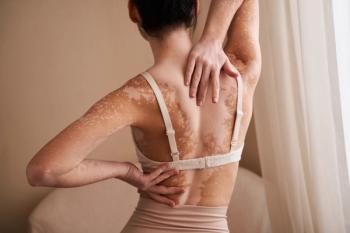
Managing Vitiligo on the Body and the Associated Comorbidities
Chesahna Kindred, MD, MBA, FAAD, and Renata Block, PA-C, review areas of the body that are typically affected, and are more problematic to manage, in patients with vitiligo. Comorbidities that put certain patients at higher risk than others are also discussed.
Episodes in this series

Heather Woolery-Lloyd, MD: When we talk about the areas of the body that are typically affected, what do you see in your practice, [Dr Kindred]?
Chesahna Kindred, MD, MBA, FAAD: The easy answer is it can affect any part of the body, but we do see distinct patterns. There’s acrofacial, where it tends to be around the eyes, the nose, the ears, the fingers. There’s also just a symmetric generalized type where it’s both hands, both elbows, etc. Segmental, we see, usually in kids, just 1 side or the other, like the left arm, the right ear, or something of that nature. When it’s generalized, I tend to see some mucosal involvement, so a good physical exam is important. Unfortunately, every so often [I see] the universal form, where nearly 100% of the body is involved.
Heather Woolery-Lloyd, MD: Yes, and those are, I think, some of our most challenging patients.
Chesahna Kindred, MD, MBA, FAAD: Most challenging. Indeed.
Heather Woolery-Lloyd, MD: Now, Renata, when you’re thinking about involvement of the body with vitiligo, are there any areas of the body that are more problematic to manage in the management of vitiligo?
Renata Block, PA-C: Yeah. This question is a really good question because we have to think of the approach of how we manage these patients, and looking at [it from] 14,000 feet, the psychosocial issues of the entire disease can be a challenge itself. But when we’re talking about the skin specifically, harder-to-treat areas are those that are devoid of hair. We’re thinking eyelids, we’re thinking the glans penis, areola area, maybe the mucosal lips, any area that has [fewer] hair follicles within it, like the fingertips or the toes, the elbows and knees. Those are definitely more difficult or challenging areas to treat. When I speak about the psychosocial issues, I’m talking about the patients with the [affected] hands. When you have a body part that you can hide or you can put makeup on, that is a little more presentable to the public. But when patients come in and they have the hands displayed all day long, it’s something that they can’t hide. I think that promotes more emotional problems for the patients. I think skinwise, those are problematic, devoid of hair follicles, but we got to look at [it from] 14,000 feet and look at the problem of treating these patients and the psychosocial platform.
Heather Woolery-Lloyd, MD: That’s a very good point because there are areas that are more challenging to treat and then there are areas that also have a bigger impact on quality of life. When we think of the more difficult areas to treat—fingertips, like you mentioned, and the hands—and when you think about the areas that tremendously affect quality of life, the face is one of the big ones that my patients want to focus on. If they can get improvement in their face, it does impact quality of life.
Renata Block, PA-C: Absolutely.
Heather Woolery-Lloyd, MD: We talked a little bit earlier about comorbidities in patients with vitiligo. [Dr Kindred], are there any comorbidities that put certain patients at higher risk than others?
Chesahna Kindred, MD, MBA, FAAD: Yes. Renata touched upon it. Thyroid disease is the most common one, but other immune diseases, such as alopecia areata, diabetes, Addison, [and] as she also mentioned, there’s anemia. Sometimes we often do a screening panel looking for other autoimmune diseases because, unfortunately, many of them don’t just show up on the skin and tell you that they’re there. We have to do testing to make sure that our patients are overall safe and well.
Heather Woolery-Lloyd, MD: Yes, I agree. I often do thyroid testing and look for other autoimmune diseases at baseline when patients present with vitiligo because we do see that overlap, specifically with the thyroid.
Transcript edited for clarity.
Newsletter
Like what you’re reading? Subscribe to Dermatology Times for weekly updates on therapies, innovations, and real-world practice tips.




















